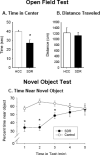Social stress enhances IL-1beta and TNF-alpha production by Porphyromonas gingivalis lipopolysaccharide-stimulated CD11b+ cells
- PMID: 19560480
- PMCID: PMC2748391
- DOI: 10.1016/j.physbeh.2009.06.013
Social stress enhances IL-1beta and TNF-alpha production by Porphyromonas gingivalis lipopolysaccharide-stimulated CD11b+ cells
Abstract
Psychological stress is associated with an increased expression of markers of peripheral inflammation, and there is a growing literature describing a link between periodontal pathogens and systemic inflammation. The hypothesis of the present work is that exposing mice to the social stressor, called social disruption (SDR), would enhance the inflammatory response to lipopolysaccharide (LPS) derived from the oral pathogen, Porphyromonas gingivalis. Mice were exposed to SDR for 2h per day on 6 consecutive days. On the morning following the last cycle of SDR, mice were tested for anxiety-like behavior in the open field test and novel object test. The mice were sacrificed the following day and their spleens harvested. Spleen cells were stimulated with LPS derived from P. gingivalis in the absence or presence of increasing doses of corticosterone. Social disruption resulted in anxiety-like behavior, and the production of IL-1beta and TNF-alpha was significantly higher in spleen cells from mice exposed to SDR in comparison to levels from non-stressed control mice. In addition, the viability of spleen cells from mice exposed to SDR was significantly greater than the viability of cells from non-stressed control mice, even in the presence of high doses of corticosterone. The use of cultures enriched for CD11b+ cells indicated that the stressor was affecting the activity of splenic myeloid cells. This study demonstrates that social stress enhances the inflammatory response to an oral pathogen and could provide a critical clue in the reported associations between stress, inflammation, and oral pathogens.
Figures






Similar articles
-
Beta adrenergic blockade decreases the immunomodulatory effects of social disruption stress.Brain Behav Immun. 2012 Oct;26(7):1150-9. doi: 10.1016/j.bbi.2012.07.011. Epub 2012 Jul 24. Brain Behav Immun. 2012. PMID: 22841997 Free PMC article.
-
Repeated social defeat activates dendritic cells and enhances Toll-like receptor dependent cytokine secretion.Brain Behav Immun. 2009 Feb;23(2):225-31. doi: 10.1016/j.bbi.2008.09.010. Epub 2008 Sep 26. Brain Behav Immun. 2009. PMID: 18848983 Free PMC article.
-
Social stress and the regulation of tumor necrosis factor-alpha secretion.Brain Behav Immun. 2005 Jul;19(4):311-7. doi: 10.1016/j.bbi.2004.09.005. Epub 2004 Nov 21. Brain Behav Immun. 2005. PMID: 15944070
-
Interleukin-1 receptor type 1-deficient mice fail to develop social stress-associated glucocorticoid resistance in the spleen.Psychoneuroendocrinology. 2008 Jan;33(1):108-17. doi: 10.1016/j.psyneuen.2007.10.007. Epub 2007 Nov 26. Psychoneuroendocrinology. 2008. PMID: 18037570 Free PMC article.
-
Stressor-induced increase in microbicidal activity of splenic macrophages is dependent upon peroxynitrite production.Infect Immun. 2012 Oct;80(10):3429-37. doi: 10.1128/IAI.00714-12. Epub 2012 Jul 23. Infect Immun. 2012. PMID: 22825446 Free PMC article.
Cited by
-
Peripheral and central effects of repeated social defeat stress: monocyte trafficking, microglial activation, and anxiety.Neuroscience. 2015 Mar 19;289:429-42. doi: 10.1016/j.neuroscience.2015.01.001. Epub 2015 Jan 14. Neuroscience. 2015. PMID: 25596319 Free PMC article. Review.
-
The Pituitary Adenylate Cyclase-Activating Polypeptide (PACAP) System of the Central Amygdala Mediates the Detrimental Effects of Chronic Social Defeat Stress in Rats.eNeuro. 2022 Sep 21;9(5):ENEURO.0260-22.2022. doi: 10.1523/ENEURO.0260-22.2022. Print 2022 Sep-Oct. eNeuro. 2022. PMID: 36566434 Free PMC article.
-
Active Ingredients of Epimedii Folium and Ligustri Lucidi Fructus Balanced GR/HSP90 to Improve the Sensitivity of Asthmatic Rats to Budesonide.Evid Based Complement Alternat Med. 2017;2017:7961231. doi: 10.1155/2017/7961231. Epub 2017 May 11. Evid Based Complement Alternat Med. 2017. PMID: 28584561 Free PMC article.
-
The intestinal microbiota are necessary for stressor-induced enhancement of splenic macrophage microbicidal activity.Brain Behav Immun. 2012 Mar;26(3):371-82. doi: 10.1016/j.bbi.2011.11.002. Epub 2011 Nov 12. Brain Behav Immun. 2012. PMID: 22100833 Free PMC article.
-
Beta adrenergic blockade decreases the immunomodulatory effects of social disruption stress.Brain Behav Immun. 2012 Oct;26(7):1150-9. doi: 10.1016/j.bbi.2012.07.011. Epub 2012 Jul 24. Brain Behav Immun. 2012. PMID: 22841997 Free PMC article.
References
-
- Pihlstrom BL, Michalowicz BS, Johnson NW. Periodontal diseases. Lancet. 2005;366:1809–1820. - PubMed
-
- Gibson FC, III, Genco CA. Porphyromonas gingivalis mediated periodontal disease and atherosclerosis: disparate diseases with commonalities in pathogenesis through TLRs. Curr. Pharm. Des. 2007;13:3665–3675. - PubMed
-
- Gibson FC, III, Ukai T, Genco CA. Engagement of specific innate immune signaling pathways during Porphyromonas gingivalis induced chronic inflammation and atherosclerosis. Front Biosci. 2008;13:2041–2059. - PubMed
-
- Paoletti R, Gotto AM, Jr., Hajjar DP. Inflammation in atherosclerosis and implications for therapy. Circulation. 2004;109:III20–III26. - PubMed
Publication types
MeSH terms
Substances
Grants and funding
LinkOut - more resources
Full Text Sources
Medical
Research Materials
Miscellaneous

